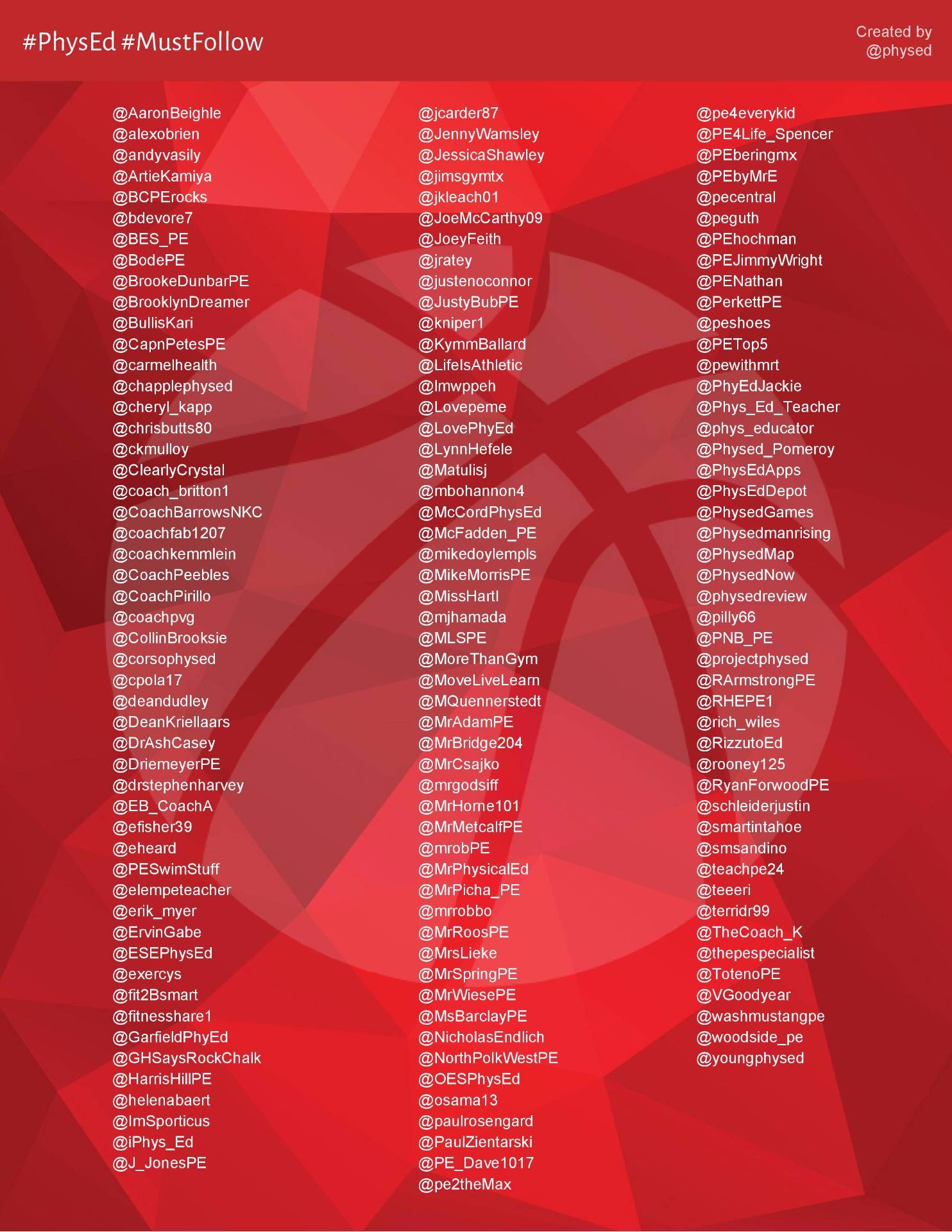Tag: #PEGeeks
Frisbee Dot Shooting
| Frisbee Dot Shooting | |
|
State Standard: 1, 2, & 4 |
|
| Equipment: One Hula-Hoop, 12 cones, 12 foam Frisbee, & several poly spots | Grade: 2-5 |
| Purpose of Event: Throwing (Frisbee tossing), teamwork, adding (math skills), & honesty. | |
| Time: 15-20 minutes | |
| Organization: Set up 6 multi-colored cones on side of the gym with another 6 on the other side. Place a foam Frisbee behind each cone on the floor. Duct tape one hula-hoop in the middle of the gym (prevent it from moving). Scatter several (15-20) poly spots around the hula-hoop with varying distances. Description: Students will work in pairs (relay style). On the signal, a student runs with their foam Frisbee in hand to a poly spot (their choice). Once they have reached their desired poly spot they attempt to toss their Frisbee into the hula-hoop while standing on the poly spot. If the students’ Frisbee lands inside the hula-hoop that student picks up their poly spot and Frisbee and returns this to their partner (placing the obtained poly spot on the floor behind their cone). Once they have made it back to their partner they hand the Frisbee to their partner who then runs to their desired poly spot and attempts to toss the Frisbee in the hula-hoop as well! Now, if the student does NOT make it in the hula-hoop they must go retrieve their Frisbee, but NOT pick-up the poly spot and wait for their next turn. This keeps going until all the poly spots are gone. Once they are all gone the teacher has the students count to see how many poly spots were obtained from each team to see who had the most. Rule: Make sure students are NOT sliding the poly spots closer to the hula-hoop! It must stay were it was originally put on the floor! |
|
| Concerns: Move safely around the gym. | |
| This idea is from: Amy Staples, Physical Education Teacher, Sioux Falls, SD. | |
A Day at the Races Field Day 2017
Chopstick Pickup
| Chopstick Pickup | |
|
State Standard: 1, 2, & 4 |
|
| Equipment: Lummi Sticks, Yarn Balls, Beanbags and Hoops. | Grade: K-3 |
| Purpose of Event: Cardiovascular Endurance, Spatial Awareness, Control, & Manipulative’s | |
| Time: 15-20 minutes | |
| Organization: Set up hula-hoops on both ends of the gym. The students will be put into pairs. Each player stands across from their partner in relay style. Each student receives a hoop, 3 beanbags, 3 yarn balls, and 2 lummi sticks. Description: Students will work in pairs. Each student places their hoop on the opposite side of the gym from his or her partner. The balls and beanbags are placed inside the hoop. On the signal to begin, each player runs with their lummi sticks to their partner hoop and attempts to use just their lummi sticks to pick up either a beanbag or a yarn ball and return it to their hoop.
Rules: If a partner drops their item while traveling back to their teammates hula-hoop they do NOT have to go back and try again. |
|
| Concerns: Move safely around the gym. Being safe with the lummi sticks!!!! | |
| This idea is from: | |
Escape From Alcatraz
| Escape From Alcatraz | |
|
State Standard: 1, 2, & 4 |
|
| Equipment: 5 Mats, 5 scooters, 5 jump ropes, 10 poly spots, & 4 Hula Hoops | Grade: 3-5 |
| Purpose of Event: Cardiovascular Endurance, Spatial Awareness, Control, & Teamwork. | |
| Time: 15-20 minutes | |
|
Organization: Set up 5 mats around the gym. Give one scooter, one jump rope, and 2 poly spots for each team. Place 4 Hula-Hoops around the gym as safe zones (rocks). Description: The goal for the students is to try and get your team around the gym using only the items listed above as many times as possible. Divide your students into five groups. Each teams starts on a mat (Alcatraz Island). Students can use the scooters (life boats), but cannot touch the floor (San Francisco Bay) with any part of their body. If, they touch the floor (water) their WHOLE group must start over. Students can use poly spots (lily pads) to stand on while moving around the gym (They are NOT allowed to slide them on the floor). Students can also stand on the hula-hoops (rocks). |
|
| Concerns: Move safely around the gym. Make sure students are not jumping onto the scooters!! They must sit on the scooters!! | |
| This idea is from: Kris Smith, Physical Education Teacher, Sioux Falls, SD. | |
Bake Shop
| Bake Shop | |
|
State Standard: 1, 2, & 4 |
|
| Equipment: 5 Mats, several yarnballs, and noodles | Grade: K-3 |
| Purpose of Event: Cardiovascular Endurance, Spatial Awarness, & Control. | |
| Time: 15-20 minutes | |
| Organization: Set up 5 mats like 5 on a dice in the gym.
Description: Put the students into 5 teams. One team is the middle of the gym on a mat they are the bakers (taggers). The 4 other teams are running and trying to steal the cookies (yarnball) and put them on their mats. After several minutes switch the bakers (taggers). Variations: Instead, of just running have the students try different locomotor skills (i.e., skipping and/or galloping) while trying to attempt to steal the “cookies.” |
|
| Concerns: Move safely around the gym. Being safe the hockey sticks!!!! | |
| This idea is from: Kurt Skogstad, Physical Education Teacher, Rosa Parks Elementary | |
Hockey: Lead-up Games
| Lead-up Games | |
|
State Standard: 1, 2, & 4 |
|
| Equipment: One hockey stick per player, One puck per game, and Cones | Grade: 3-5 |
| Purpose of Event: Stick-Handling, Shooting, Checking, Goaltending, and Teamwork | |
| Time: 15-20 minutes | |
| Organization: Give students a stick and have them sit down in their homes. Explain to the students the safety precautions they need to take when playing with the sticks. No “High Sticking”! Tell the player we are reinforcing the hockey skills we have learned through these lead-up games.
SHOOTING SKILLS:
Variations:
|
|
| Concerns: Move safely around the gym. Being safe the hockey sticks!!!! | |
| This idea is from: Myself | |
Hockey: Passing & Receiving Skills
| Passing and Receiving Skills | |
|
State Standard: 1, 2, & 4 |
|
| Equipment: One hockey stick per player, One puck per pair, One ball per pair, and Several cones | Grade: 3-5 |
| Purpose of Event: Passing technique, Receiving, Control, and Partnerwork | |
| Time: 15-20 minutes | |
| Organization: Give students a stick and have them sit down in their homes. Explain to the students the safety precautions they need to take when playing with the sticks. No “High Sticking”! Have players find a partner. Each pair gets one puck and stands ten feet apart.
Passing & Receiving Skills:
Variations: You can set up these different learning activities into centers if you would like too. |
|
| Concerns: Move safely around the gym. Being safe the hockey sticks!!!! | |
| This idea is from: Myself | |
Stick Handling Skills
| Stick Handling Skills | |
|
State Standard: 1, 2, & 4 |
|
| Equipment: Several large mats, scooters, tag sticks, & poly spots. | Grade: K-3 |
| Purpose of Event: Hopping, Leaping, Manipulation, Aerobic Fitness & Spatial Awareness | |
| Time: 15-20 minutes | |
| Organization: Give students a stick and have them sit down in their homes. Explain to the students the safety precautions they need to take when playing with the sticks. No High Sticking! Have the students first practice these skills at their homes spaces.
Stick Handling Skills:
Square–Box Hockey: (Form four teams with an even number of players on each team. Have each team stand on one side of a 30-foot square. Each team numbers off.) When a number is called, all players with that number, run to the middle, dribble a puck out of the middle, through the spot just vacated, CCW around the square, and back through your vacant spot to place the puck back in the middle. Variations: You can set up these different learning activities into centers if you would like too. |
|
| Concerns: Move safely around the gym. Being safe the hockey sticks!!!! | |
| This idea is from: Myself | |
Island Hopping
| Island Hopping | |
|
State Standard: 1, 2, & 4 |
|
| Equipment: Several large mats, scooters, tag sticks, & poly spots. | Grade: K-5 |
| Purpose of Event: Hopping, Leaping, Manipulation, Aerobic Fitness & Spatial Awareness | |
| Time: 15-20 minutes | |
|
Organization: Set-up several large mats in rows (Velcro them together) with space in between each row. This allows for the students to be able to see the floor. Place four scooters with tag sticks (noodles) on each scooter in between the rows of mats (pirates). Place several poly spots on each end of the gym (Lilly pads). Island Hopping: Separate the students into two groups. One group will be at on end of the gym standing the on the ploy spots. The other group is standing on the other end of the gym on poly spots. The poly spots represent the lily pads (students not standing on the floor). After separated, tell the class they are to hop or leap from their lily pads onto the rows of mats (islands) without touching the floor. The students are to keep hopping/leaping from each row of mats (island) from one end of the gym to the other. I have 4 rows of mats set-up in my gym. Once the students have reached the end the run around the outside and start again (or you can have them turn around and hop or leap where they came from). If a student touches the floor while attempting to hop from one island to the other they must perform a specific exercise before returning to the game. Variations: I place four students on scooters with tag sticks (swords) these are the “pirates.” If a student is tagged by a pirate before they reach the island they must perform a specific exercise. This activity is sometimes referred to as “Frogger” or “Crossy Roads.” During Valentine’s Day the taggers are the “Cupid’s” when students get tagged they make them “fall in love with exercise.” |
|
| Concerns: Move safely around the gym. | |
| This idea is from: Justin Cahill, K-5 Physical Education Teacher, Altanta, GA. | |
Proudly powered by WordPress.
Theme: Flat by YoArts.

